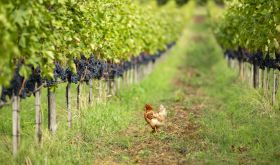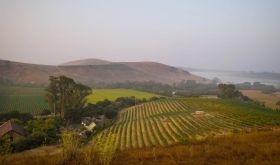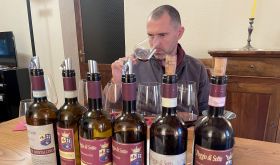I just love the way California wine producers co-operate, commingle and discuss – so much more pro-active than most of their European counterparts. Below is a report compiled, surely with enormous difficulty, on a meeting of six Carneros winemakers who gathered at Domaine Carneros early in April to discuss ripeness, a hot topic in the wake of two vintages characterized by heatwaves and soaring sugars at harvest. Sponsored by the Carneros Quality Alliance, the panel discussion included Syrah, Merlot, Chardonnay, Albariño and sparkling wines, but the focus was on Pinot Noir, produced mostly in limited quantities by five of the participants. The discussion is highly relevant to topics such as hang time and alcohol levels which we have been considering on this site. See below for some related articles.
Moderator David Graves of Saintsbury noted that “wine styles are very much a human creation, and we make a huge number of choices to influence style.” He added that “in Carneros, we’ve gone through a complete reworking of the vineyard infrastructure.” Then he asked, “Why are alcohol levels rising, and why is fruit being picked at an ever riper level?”
“We do look for richness that comes with a certain alcohol,” answered Anne Moller-Racke, president of The Donum Estate and viticulturist for Robert Stemmler winery. “You want flavor development at lower sugars if possible, but there is a sweet point you want to hit.”
To make luscious, intense wines that are not alcoholic, she explained, “we work on the edge, because if you wait at 24 degrees sugar and it gets warm, even with 5% to 10% dehydration that you can’t feel, you are quickly at 26 or 27 degrees.”
Ripeness decisions begin at pruning, she said. “Pruning and suckering may sound like a recipe, but each time you must vary the ingredients depending on the vintage.” Her biggest challenge is to understand the vintage as early as possible, then advise the winemaker. With attention to detail and knowledge of the vineyard’s history, “you can predict and make good decisions.”
Cooler years present a different challenge, Moller-Racke stated. “In 1999, we had all the hang time in the world and wonderful flavors at only 23 degrees Brix, but that doesn’t give richness in the mouth.”
Wayne Donaldson, winemaker at Domaine Chandon, agreed that in “just about every season I’ve had in California (we’re) sitting at 23.5 or 24 Brix and flavor profiles (are) right there and then, slam, we get hit.” Coming from Australia’s Yarra Valley, he has had to deal with California’s “incredible sunshine.” For whatever reason, Donaldson remarked, the consumer palate “is being guided towards bigger, richer, viscous, unctuous, fat, gooey wines,” and the sun helps make them, but it doesn’t necessarily help achieve physiological ripeness.
Sugars, flavors and tannins “are all linked…but they do have different maturation paths,” Donaldson said. “That’s the conundrum, trying to make wines with all these things in balance, yet we’re being hammered with alcohol.”
“And is climate changing, is it getting warmer?” he asked. “Maybe assuming that our terroir is always going to be static is flawed.” Donaldson says long-term strategies should focus on the vineyard -- on clones, rootstocks and cultural practices. For example, with vertical canopies, he thinks orienting rows into the sun can shade fruit and keep it cooler, “stretching that (hang time) window out a bit.”
Graves agreed that “it’s easy to go too far in the world of sun exposure in the vineyard canopy,” suggesting that “maybe the pendulum is swinging back a little towards open shade rather than full sun.”
James Hall, winemaker at Patz & Hall, said that in making the most important decision of the year -- when to harvest -- he prefers the term “maturity,” implying that before it is reached, “there’s a state of immaturity.”
“Over the years,” Hall said, “I’ve learned that grapes higher in sugar and with riper tannins, particularly riper seeds, allow for fuller extraction in the winery.” He concurred that fall heat waves are frustrating and “a logistical nightmare to get all the fruit in. That said, it doesn’t necessarily mean the vintage is a failure or that the wines are unbalanced. It just means it’s necessary to address that in the winery.”
Hall recalled that, in the 1980s, “people were very obsessed with…total acidity and…picking based on pH, and those wines really didn’t have the flavor profile or depth of character that I think wines have these days. Alcohol is the inverse of that, and too much of any one component is clearly not desirable.”
But in a vintage like 2004, or 2003 in Europe, “you have to play the hands you are dealt,” Hall pointed out. “Personally, I don’t think I have that much control over the process. The weather and the vineyard have their own trajectory, and I’m along for the ride. Sure, we can irrigate a little bit, leaf strip, thin some fruit, but (that) won’t change the fundamental character of the vineyard.”
Asked if grapes jumped in ripeness in other places where he sources grapes, Hall replied, “Yes. It’s a function of the weather. In 2004, we had an offshore flow of wind out of the Central Valley, very low humidity in some cases approaching single digits, and hot temperatures. That desiccated the fruit. Everywhere. In Russian River, Carneros, the Santa Lucia Highlands, Mendocino and the Central Coast, the same thing.”
“But it’s really 2003 and 2004,” he explained. “I hesitate to make general conclusions about terroir and climate based on two warm vintages. We’ve had some cool years, too.”
A comment from the audience that rain re-hydrates grapes in Europe, but California growers aren’t willing to irrigate and want to add water in the cellar brought a chorus of disagreement from Moller-Racke and Graves.
Graves recalled that in the early 1980s, vines were relatively well-watered until veraison, then irrigation ceased. If vines were subjected to a great deal of thermal stress, they stopped ripening their fruit. Now, while we want shoot tips to stop growing at veraison, Graves
noted, “we tend to irrigate much more from veraison on than we used to…in a way that would have been unthinkable 25 years ago.”
“I think there’s a physiological issue for grapevines once the fruit gets to about 25 Brix,” Graves added. “You could totally soak the vineyard with water and not affect the berries.”
“That’s what happened in 2004,” said Hall. “We watered like crazy and there was just no keeping up. It was a house on fire.”
Ken Bernards, winemaker at Ancien Winery, said every region has its own inherent challenges. “With the Burgundy model, in some vintages you have trouble reaching sugar and physiological ripeness, and the reverse is sometimes true here. In the winery, we have developed techniques (to) deal with what nature doesn’t give us.”
“The thing we keep talking about…the north wind…is the reversal of what we usually have. We have marine influence and (the wind) pushes it off. When that happens, timing is everything,” according to Bernards. “In a given vintage, James might be bemoaning the heat and low humidity, and I may be picking a week earlier or later and be in a different window.”
Michael Havens, winemaker at Havens Wine Cellars, said his response to the question of ripeness “has been to choose varieties that I think exhibit characteristics (when) grown in Carneros that I find pleasing.”
Havens said he “values a balance between the bones and the flesh – the tannins and acid on one side and fruit extract and alcohol on the other, because alcohol is a sweetener, and the oak, which can be both a tannin and a sweet contributor. I like those things to be pleasingly balanced in the mouth (to) complement food.”
Havens contended that most winemaking focuses on qualities easily appreciated by most people, and “that means sweetness.” Instead of a balance among elements, there is a domination of sweetness. “A lot of winemaking has become formulaic…focus-group winemaking,” he said. “But I appreciate a balance that’s different. I focused on varieties that ripen differently in Carneros – Merlot, Cabernet Franc, Syrah, and…Albariño.”
“Ripeness is not a single issue; it’s complex,” he continued. Havens spoke of four ripeness clocks running simultaneously but at different rates – sugar accumulation, acid transpiration, phenolic ripeness and fruit character. In his varieties and to some degree in Burgundian varieties as well, fruit character starts at vegetal, moves to herbal, to fruity, then jammy and finally, cooked.
According to Havens, there’s no single correct place in that series of fruit characters and on the other clocks: “I think we should be able to appreciate different senses of style and balance and fruit characteristics.”
Anne Moller-Racke also has balance in mind in the way she wants her vines to look. “Crop level with Pinot Noir has become so important,” she said. “That’s (a) major leap we’ve made, less crop, and the proper amount differs every year, mainly having to do with shoot size.”
“Once I have bloom,” she explained, “I know normally I will have harvest 115 days later. In 2004, I knew when we were blooming on May 3rd, we’d be picking in August. That wasn’t rocket science. From there, you look at weather data for the last five years and determine how hot the days were in the ripening zone you fall into. With that bigger picture, you can really work on the details with an idea of what your challenges will be.”
For Ken Bernards, “there’s a new Carneros versus old Carneros thing happening. Certainly phylloxera played a big role in that.” Bernards said he has gone from 30-year-old, Martini clone, St. George rootstock, wide-spaced, old school Pinot Noir to newer viticulture. “The 30-year-old, virused Pinot Noir was a little more forgiving in weathering heat spells,” he noted. “It just kept going. Young vines…are less forgiving. I picked riper the last four years than I did the previous four years.”
Is he changing his style? No, said Bernards. “The reality is, I have younger vines that flash more; as I walk that razor edge of ripeness, things become more challenging faster. I think that will change. As vines age, they’ll be more forgiving and maturation will slow down.”
Hall questioned the perceptions of winemakers, consumers and the media: “Everybody has all these number models in their minds…and 28 Brix is too ripe. Well, 28 Brix means there’s not enough water in the grape, and that’s about all.”
Is 14% alcohol too high? “Does the wine taste alcoholic or doesn’t it?” Hall asked. “I’m often surprised when we run alcohols (after) harvest…and I taste something and say, ‘Aha! It’s over 14 and it’s kind of hot!’ And you forget about the other 12 wines you tasted that were 14.5% to 15% that didn’t taste hot. So there’s something to focus on beside the number. Does the wine work or doesn’t it? That makes it real simple.”
Bernards agreed: “I’ve had Pinot Noir over 15% that was in balance.” Bernards said the best of expression of a vineyard can be higher or lower alcohol, that there is a sweet spot with the best balance of richness, texture and aromatics. “I’m thinking that 13.6% to 14.5% is the range I’ve worked with in Carneros Pinot Noir for most of my career.” He pointed out that the best vintages of Burgundy tend to have alcohols in the “upper thirteens…even pushing 14%. And they are in balance and rich and everything works.”
Bernards predicted that alcohols will probably drop over the next five to ten years. “In the market now, everyone is becoming interested in low-alcohol, tank-fermented Chardonnay, for instance.” One reason is just the passage of time, he said, because “the market is always in evolution.”
CONTACT: Dan Gustafson dangustafson@sbcglobal.net (707) 363-0963












